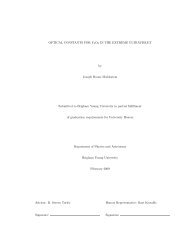Acoustic Scattering from a Sphere - Steve Turley
Acoustic Scattering from a Sphere - Steve Turley
Acoustic Scattering from a Sphere - Steve Turley
You also want an ePaper? Increase the reach of your titles
YUMPU automatically turns print PDFs into web optimized ePapers that Google loves.
1.4 Solutions in Spherical CoordinatesA separable solutions to Equation 1 can be found in spherical coordinates. There are two classes of solutions.The rst set of solutions are valid everywhere in space, but don't satisfy the radiation condition. They arecalled the complete solutions.V m n (x) = j n (kx)Y m n (ˆx) , (15)where x = |x|, j n are the regular spherical Bessel functions, and Ynm are the spherical harmonics. The secondclass of solutions satisfy the Sommerfeld radiation condition, but are not regular at the origin. They arecalled the radiating solutions.Wn m (x) = h (1)n (kx)Yn m (ˆx) , (16)where h n are the spherical Hankel functions withh (1)n (z) = j n (z) + iy n (z) . (17)The spherical Bessel functions are related to the regular Bessel functions by the relationf n (z) =√ π2z F n+1/2(z) , (18)where f n is one of j n , y n , or h n and F is one of J, Y , or H. The radiating solutions are complete in thesense that any radiating solution can be expanded as a linear combination of the terms in Equation 16.u(x) =∞∑n∑n=0 m=−na m n h (1)n (kx)Y m n (ˆx) . (19)The coecients a m n are determined by the bondary conditions in the problem. Once these coecients havebeen determined, the scattering amplitude in Equation 14 can be expressed asf(ˆx) = 1 k∞∑n=01i n+1n∑m=−na m n Y m n (ˆx) . (20)It will be useful later to have an expansion of the Green's function in Equation 11 in terms of these twosolutions. It is∞∑ n∑G(x, x ′ ) = ik Wn m (x)Vn m (x ′ ) , (21)n=0 m=−nwhere the overbar denotes the complex conjugate of an expression.2 PotentialsIt is convenient to solve scattering problems in terms of acoustic single-layer and acoustic double-layerpotentials. Physically, these correspond to continuous layers of monopoles and dipoles on the surface ofthe scatterer. The potentials are solutions to Equation 1 inside and outside the scatterer and satisfy theSommerfeldt radiation condition. The single-layer potential u and double-layer potential v away <strong>from</strong> thesurface are∫u(x) = ρ(x ′ )G(x, x ′ ) ds(x ′ ) (22)v(x) =∂D∫ρ(x ′ ) ∂G(x, x′ )∂ˆn(x ′ ds(x ′ ) .)(23)∂DExamination of Equation 12 shows that solutions of Equation 11 can be expressed as a combination ofEquations 22 and 23 with the densities ρ being the values of u or its normal derivative on the boundary ofthe scatterer.4





